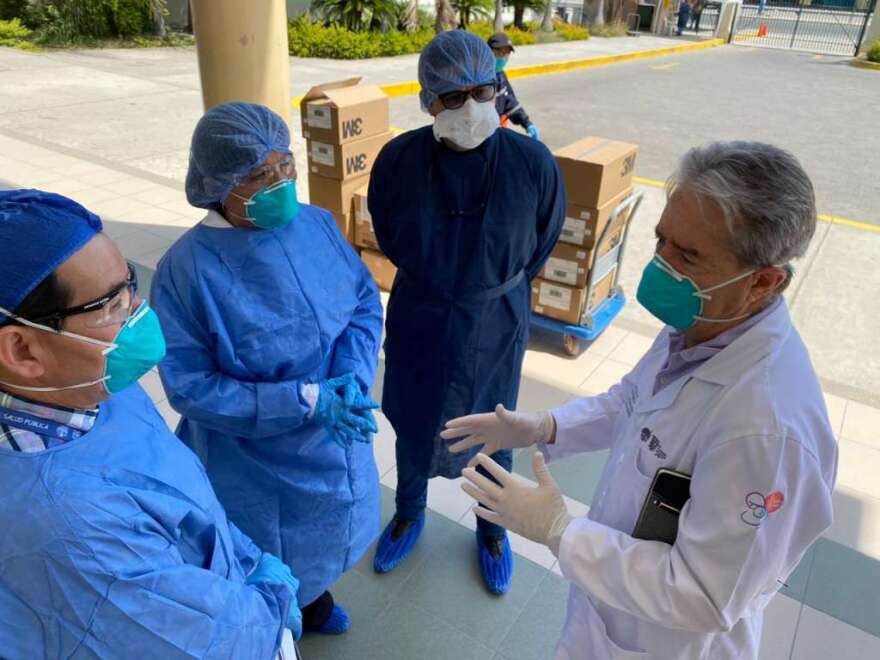Ecuador's new health minister, Dr. Juan Carlos Zevallos, talks with WLRN's Latin America Report about the "horrifying" experience of trying to get his country's COVID-19 pandemic crisis under control. Calling Ecuador unprepared, he says, is "absolutely unfair."
In these uncertain times, you can rely on WLRN to keep you current on local news and information. Your support is what keeps WLRN strong. Please become a member today. Donate Now. Thank you.
Last week WLRN’s Latin America Report looked at how hard COVID-19 has hit Ecuador. The country is widely regarded as the pandemic’s epicenter in Latin America and the Caribbean – especially its overwhelmed port city of Guayaquil, which was recently the awful scene of corpses lying unburied on sidewalks.
But Ecuador is starting to climb back. Last week, its official growth curve of COVID-19 cases began to flatten (before ticking up again over the weekend). In late March, Ecuadorian President Lenín Moreno appointed Dr. Juan Carlos Zevallos as his new health minister to get control of the mushrooming crisis. Zevallos, who once taught at Florida International University, spoke to WLRN’s Tim Padgett from Quito.
Excerpts from their conversation:
WLRN: What are the strongest signs you see that Ecuador's COVID-19 pandemic emergency is beginning to improve?
ZEVALLOS: There are several indicators. One is the number of deaths is coming down, specifically in the city of Guayaquil that was hit very hard. Second is the number of emergency requests; admissions to the hospitals is another. Also – the [coronavirus] transmission rate. All of them down, specifically in Guayaquil.
READ MORE: Expats: Ecuador's COVID-19 Meltdown Is a Warning for American Too
The mayor of Guayaquil described the pandemic as “a Hiroshima bomb” falling on her city. How would you describe what you saw there?
Horrifying. Horrifying. When I came on as minister, I moved to the city – the whole Ministry of Public Health was moved there, and it was terrifying. The number of dead people, the corpses, the number of people seeking aid at the hospitals, all the hospitals full.
A lot of people died in their homes, especially at the beginning. But I remember a woman that was living in the United States – she was living in Miami – and her father died in a hospital in Guayaquil. She didn't have any relatives in Guayaquil specifically, and the rest of the family was living out in the [Ecuadorian] countryside. They couldn't go to Guayquil because there's a lockdown between cities here. And so nobody could claim the body. So the suffering of that woman in Miami, not being able to bury her father, was very shocking.
It is absolutely unfair to say Ecuador was unprepared. I mean, if you see New York or Madrid or Wuhan, there was exactly the same thing. –Dr. Juan Carlos Zevallos
What was the pressure like for you taking on this role as health minister at such a life-and-death moment for the country?
It was very hard at the beginning. But we had a plan. You know, I was trained at the CDC [the U.S. Centers for Disease Control and Prevention] and that helped me to implement a plan of rapid hiring of people, physicians and nurses and so on; and improvement of the hospitals and of intensive care units. And we started importing all the [coronavirus] tests possible in order to identify cases and vulnerable populations. I think with that plan we contained a lot of the spread of the virus.
Guayaquil officials and the New York Times estimate COVID-19 has killed 10 times more people in Ecuador than what the government is officially reporting. Whose numbers should we trust?
We have compared the number of people that died in the same months in previous years; and in 2020 there is an excess of around 7000 deaths, and it’s attributable to the coronavirus. But we want to do a better classification of that.
TWELVE-DOLLAR MASKS
You're an epidemiologist, and most of your colleagues believe Ecuador's emergency was caused largely by infected Ecuadorians returning home from Europe. Because of those images from Guayaquil, there is an assumption that the country was not prepared for this pandemic. Reports have accused your predecessor, for example, of paying $12 for protective masks that shouldn’t have cost more than a few dollars. Are the criticisms fair?
It is absolutely unfair to say Ecuador was unprepared. I mean, if you see New York or Madrid or Wuhan, there was exactly the same thing. Even a very strong health system cannot contain a very tragic situation like this. The cost of masks and tests and all the protective equipment – it has been a nightmare, because we have to compete with many other countries that are in exactly the same situation.

The Ecuadorian government implemented lockdown measures very early on. But unfortunately, the people did not care for the lockdown, and many continued to got out to social events and everything – and that really took a toll on the transmission rate. A lot of people got infected.
You were a medical professor here at FIU. So when you see those images of Americans protesting the stay-at-home rules here, what's your advice to them?
They’re completely wrong. Don't do it. It is too risky. This is a very contagious virus. It's going to kill a lot of people. The U.S. is now at the top of the death toll in the world.
By the same token, is Ecuador receiving enough U.S. aid to help it get through this pandemic – as much as, say, the country’s been getting from China?
I am in personal contact with the U.S. ambassador here, Michael Fitzpatrick, and that has been very helpful. I think President Moreno talked with President Trump again a few days ago. At this point I’m not completely sure what “enough” means. We still need a lot.


